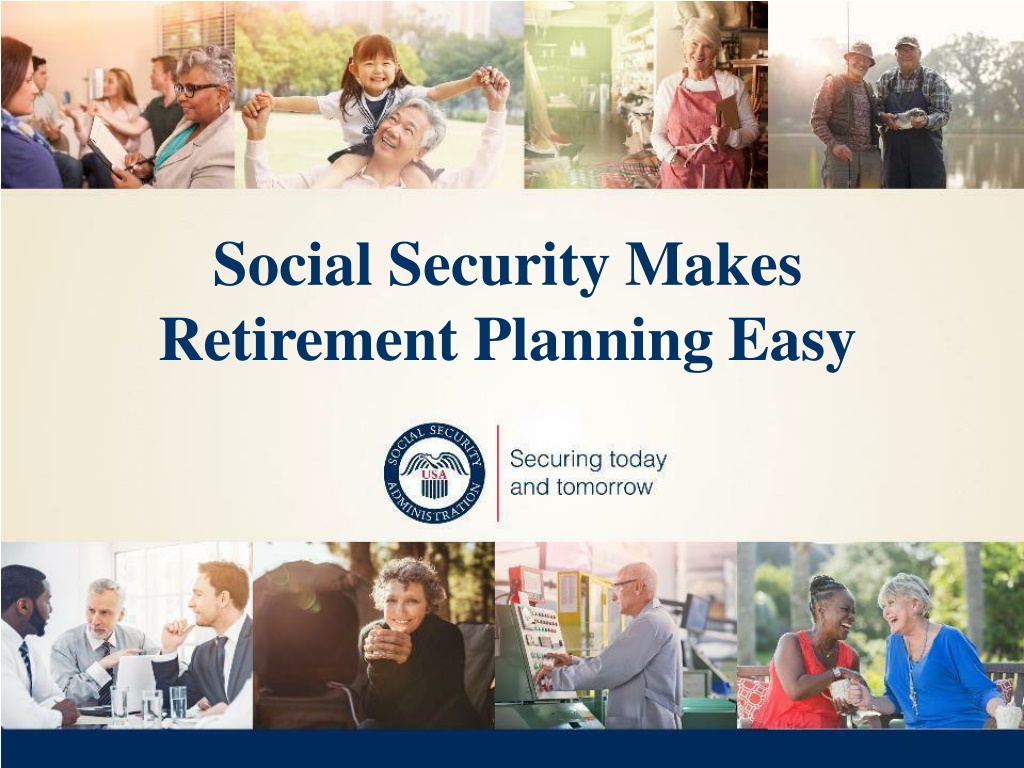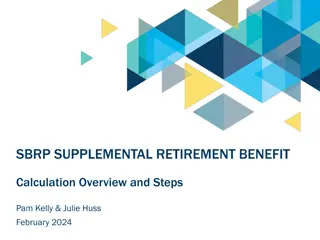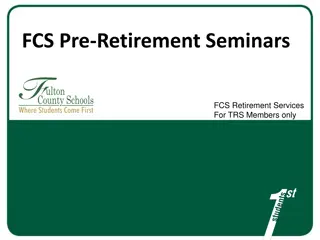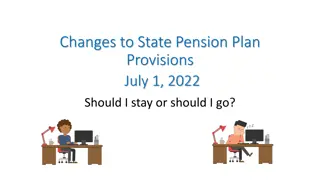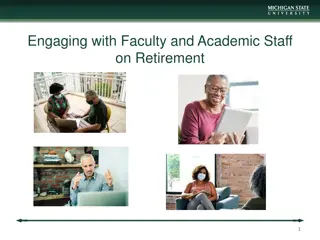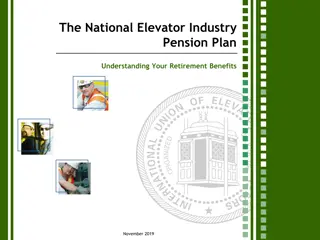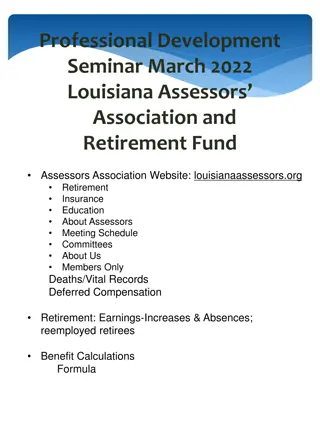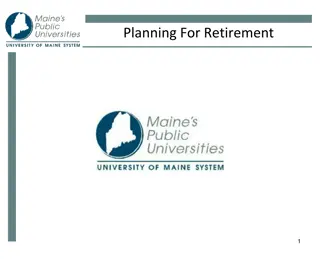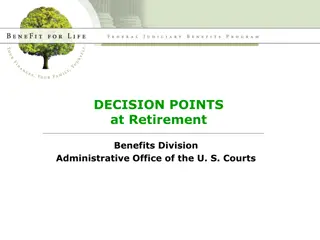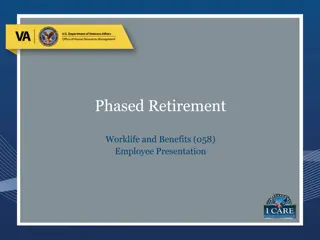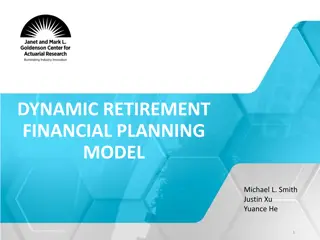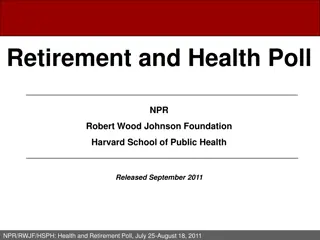Understanding Social Security Retirement Benefits
Social Security makes retirement planning easy by providing benefits based on earned credits and taxes paid. To qualify for retirement benefits, you need 40 credits (10 years of work) and must be 62 or older. Benefit amounts are determined by your earnings history and adjusted for wage levels. Knowing the age to receive full benefits and when to retire can maximize your benefits. Spouses and divorced individuals may also be eligible for benefits based on certain criteria.
Download Presentation

Please find below an Image/Link to download the presentation.
The content on the website is provided AS IS for your information and personal use only. It may not be sold, licensed, or shared on other websites without obtaining consent from the author. Download presentation by click this link. If you encounter any issues during the download, it is possible that the publisher has removed the file from their server.
E N D
Presentation Transcript
Social Security Makes Retirement Planning Easy
How Do You Qualify for Retirement Benefits? By earning credits when you work and pay Social Security taxes You need 40 credits (10 years of work) and you must be 62 or older Each $1,320 in earnings gives you one credit You can earn a maximum of 4 credits per year Note: To earn 4 credits in 2018 you must earn at least $5,280.00.
How Social Security Determines YourBenefit? Social Security benefits are based on earnings Step 1 -Your wages are adjusted for changes in wage levels over time Step 2 -Find the monthly average of your 35 highest earnings years Step 3 -Result is average indexed monthly earnings
Age to Receive Full Social Security Benefits Year of Birth Full RetirementAge 1937 orearlier 65 1938 65 & 2months 1939 65 & 4months 1940 65 & 6months 1941 65 & 8months 1942 65 & 10months 1943-1954 66 1955 66 & 2months 1956 66 & 4months 1957 66 & 6months 1958 66 & 8months 1959 66 & 10months 1960 orlater 67
What Is the Best Age toRetire? Age You Choose to Start Receiving Benefits
Spouse (living) benefits Survivor (death) benefits Can start from age 60 to Full Retirement Age (FRA) Can start from age 62 to Full Retirement Age (FRA) 71.5% at age 60 and increases each month you wait, up to 100% if you start at FRA 50% at FRA or less if you start prior to FRA (reduction for each month you take it early) Divorced spouses qualify if marriage lasted at least 10 years Divorced spouses qualify if marriage lasted at least 10 years
If You AreDivorced A person can receive benefits as a divorced spouse on a former spouse s Social Security record if not married: Was married to the former spouse for at least 10 years; Is at least 62 years old; Is unmarried; and Is not entitled to a higher Social Security benefit on his or her own record.
Survivor Eligibility Factors Child Can receive benefit if notmarried and under age 18 (or under age 19 if still in high school). Disabled Child Can receive benefits beyondage 18 if not married and was disabled before age 22. Widow / Widower Can get full benefits at full retirement age or reduced benefits at age 60 or as early as age 50 if disabled or at any age if caring for child under 16or a disabled child.
Working While Receiving Benefits If you earn more, some benefits will be withheld If you are You can make up to $17,040/yr. ($1,420/mo.) $1 for every$2 Under Full RetirementAge $45,360/yr. ($3,780/mo.) $1 for every$3 The Year Full Retirement Ageis Reached No Limit No Limit Month of Full RetirementAge andAbove Note: If some of your retirement benefits are withheld because of your earnings, your benefits will be increased starting at your full retirement age to take into account those months in which benefits were withheld.
Income That Does NOT Count as Earnings Income That Counts as Earnings Inheritance payments Gross wages from employment Pensions Net earnings from self- employment Income from investments Interest and dividends Capital gains Other sources
Taxation of Social Security Benefits Ifyou: file a federal tax return as an "individual" and your combined income* is between $25,000 and $34,000, you may have to pay income tax on up to 50percent of yourbenefits. more than $34,000, up to 85 percent of your benefits may betaxable. file a joint return, and you and your spouse have a combined income* that is between $32,000 and $44,000, you may have to pay income tax on up to 50percent of yourbenefits more than $44,000, up to 85 percent of your benefits may betaxable. are married and file a separate tax return, you probably will pay taxes on yourbenefits. Your adjusted grossincome + Nontaxableinterest + of your Social Securitybenefits = Your "combinedincome No one pays federal income tax on more than 85 percent of his or her Social Security benefits, based on Internal RevenueService (IRS)rules Visit IRS.gov and search for Publication 554, Tax Guide for Seniors, and Publication 915, Social Security And Equivalent Railroad Retirement Benefits
Windfall Elimination Provision (WEP) If any part of your pension is based on work not covered by Social Security, you may be affected by the Windfall Elimination Provision.
Windfall Elimination Provision (WEP) Normal Computation WEP Computation 90% of the First $895 40% of the First $895 32% of the Next $5,397 32% of the Next $5,397 15% of the Remainder 15% of the Remainder The average reduction is $280 amonth The maximum reduction possible is $428.00 amonth
Windfall Elimination Provision (WEP) Years of Social Security Coverage % of First Factor in Benefit Formula 30 or more 29 28 27 26 25 24 23 22 21 20 or fewer 90 85 80 75 70 65 60 55 50 45 40
Government Pension Offset (GPO) If you receive a government pension based on work not covered by Social Security, your Social Security spouse s or widow(er) s benefits may be reduced.
Government Pension Offset (GPO) Applies to Spouse s Benefits Only 2/3 of amount of government pension will be used to reduce the Social Security spouse s benefit Example: $1,200 of government pension; Social Security spouse s benefit 2/3 = $800 - $750 -$50 No benefit payable by Social Security
Social Securitys Disability Definition: A medical condition or combination of impairments preventing substantial work for at least 12 months, or expected to result in death. The determination also considers age, education, and work experience
How Do You Qualify for Disability Benefits? Must have paid into Social Security five out of the last 10 years For workers under age 31 less work is required Must have paid Social Security taxes for half the time since age21 Paid Social Security Taxes 1 years Example: Age24 Paid Social Security Taxes 4 years Age 29
Who Can Get Disability Benefits? Child Can receive benefit if notmarried and under age 18 (or under age 19 if still in high school). Disabled Child Can receive benefits beyondage 18 if not married and was disabled before age 22. Spouse Can get full benefits at full retirement age or reduced benefits at age 62 or at anyage if caring for child under 16 or a disabled child. Divorced spouses may qualify
Medicare Part A = Hospital Insurance Part B = Medical Insurance Part C = Medicare Advantage Plans Part D = Prescription Drug Plans Visit Medicare.gov for details
Age 65 After 24 months of SSDI ALS Medicare Eligibility Kidney failure Environmental health hazard exposure
Initial Enrollment Period Begins 3 months before your 65th birthday and ends 3 months after that birthday Medicare Enrollment Special Enrollment Period If 65 or older, you & your spouse are still working, and you are covered under a group health plan General Enrollment Period January 1 March 31
P, FARCH =MFNIJ - I Socia l Security l!l s1GN IN / t1P 1."111NG1JIIGFs aa EID ? Q my Social Security Retirement Estimator Online Services FAQs Whetheryou areapplyingror ot re<civ,ng benefits, learnwhat you candoonline. Check out your Soc,ol Secumy Stotemem. changeyouraddress &manageyour bene fits.. Calc:ula te yo>.Jr benefits based on youractualSocial Security earningsrecord. Get answers to frequentlyasked questionsaboutSocialSecunty. Securing today and tomorrow Socia1Security.gov
my Social Security socialsecurity.gov/myaccount
my Social Security Services If you do not receive benefits, you can: Request a replacement Social Security card if you meet certain requirements; Check the status of your application or appeal; Get your Social Security Statement to review: o Estimates of your future retirement, disability, and survivor benefits; o Your earnings once a year to verify the amounts that we posted are correct; and o The estimated Social Security and Medicare taxes you ve paid.
my Social Security Services If you receive benefits or have Medicare, you can: Request a replacement Social Security card if you meet certain requirements; Get a benefit verification letter as proof that you are getting benefits; Check your benefit and payment information and your earnings record; Change your address and phone number; Start or change direct deposit of your benefit payment; Get a replacement Medicare card; and Get a replacement SSA-1099 or SSA-1042S for tax season.
How to open a my Social Security account 1 2 Visit socialsecurity.gov/myaccount Select: Sign In or Create anAccount Provide some personal information to verify your identity. 3 4 Choose a username and password to create youraccount.
SelectHere socialsecurity.gov/estimator
Applying for Benefits 3 options available to apply: Online By phone 1-800-772-1213 At our office You choose the most convenient option for you! Note: Supplemental Security Income (SSI), child and survivor claims can only be done by phone or in a field office (not online) at this time. We are developing an online SSIapplication.
If you have questions, a valuable resource on our website is our FAQs or Call Social Security toll-free at 1-800-772-1213 TTY1-800-325-0778 7 am 7 pm Monday Friday Automated Phone Service 24/7
